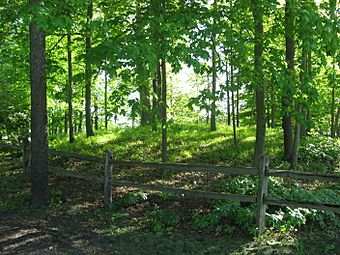Dunns Pond Mound facts for kids
Quick facts for kids |
|
|
Dunns Pond Mound
|
|

Northeastern side of the mound
|
|
| Location | Junction of Mohawk and Mound Aves., northeast of Dunns Pond |
|---|---|
| Nearest city | Huntsville, Ohio |
| Area | 1 acre (0.40 ha) |
| NRHP reference No. | 74001548 |
| Added to NRHP | July 30, 1974 |
The Dunns Pond Mound is an old Native American mound, which is a type of earth mound, located in Logan County, Ohio, United States. It's found near Huntsville, right by the southeastern part of Indian Lake. This mound is a very important historical site. In 1974, it was added to the National Register of Historic Places. This means it's recognized as a place that could teach us a lot about ancient people. It was used as a burial site for a very long time, possibly for as much as nine centuries.
There are other similar Native American earthworks in the area. A study done in 1914 found fifteen mounds on the southeastern side of Indian Lake. This group of mounds was seen as a key place for archaeological discoveries in Logan County. Four more mounds in Washington Township, which weren't part of the 1914 study, are on Lake Ridge Island. These mounds, called the Lake Ridge Island Mounds, were also added to the National Register on the same day as the Dunns Pond Mound.
Contents
What is the Dunns Pond Mound?
The Dunns Pond Mound is believed to have been built by the ancient Hopewell people. They lived in this area between 300 BC and AD 600. Today, about twenty mounds have been found around southeastern Indian Lake. However, it's likely that many more existed long ago.
How Indian Lake Changed the Area
In 1860, a dam was built on the Miami River. This made Indian Lake much larger than it naturally was. Farmland became covered by water, and small hills turned into islands. The Dunns Pond Mound suddenly found itself close to the new shoreline. A small part of the lake just south of the mound was later named Dunns Pond. It's possible that any villages or mounds northwest of Dunns Pond Mound are now underwater.
Discovering the Mound's Secrets
For many years after the lake grew, the Dunns Pond Mound was not well known. It was surrounded by trees. The only human activity nearby was a path for bicycles and snowmobiles that went over the mound. People tried to dig into the mound in the early 1940s, but they stopped without finding anything major.
However, archaeologists continued to be interested in the mound. In 1974, it was listed on the National Register. This was because it was likely to hold important information about people from the past. The mound was probably built by the Hopewell people for their burial ceremonies. Later, people from the Late Woodland period also used the mound as a burial site.
Modern Interest in the Mound
In recent years, more people have become interested in the mound. In the early 1900s, local Boy Scouts wanted to clear the brush from the mound. They saw it as a conservation project. However, the owner of the land did not allow it.
More homes and buildings have been built around Indian Lake. A small community called Moundwood grew up around Dunns Pond. The mound is located at the edge of this community. It's not easy to get to the mound anymore. The old trail has been removed, and a fence has been put around the mound.



